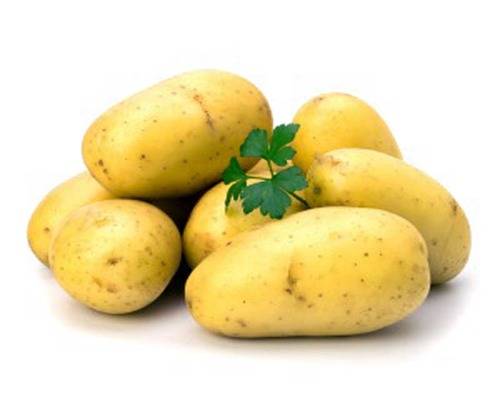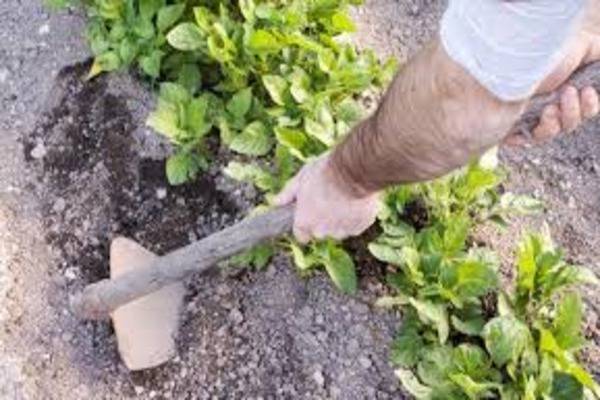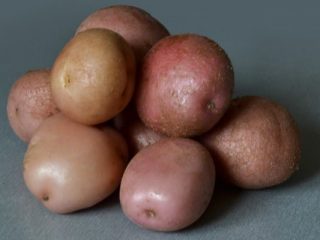Content
The Limonka potato variety was the result of the work of Dutch breeders. Fruits well in the Central and Central Black Earth regions of Russia and Ukraine.
Description
Table potatoes of the Limonka variety are classified as medium-late. The ripening period lasts from 110 to 130 days, and the harvest can be assessed in late August early September. Sprawling, tall bushes are formed by thick, tall stems. The white flowers are modest in size. The leaves are characterized by an average size.
The weight of mature tubers is 80-140 g. The peel of the Limonka potato has a heterogeneous color (yellow-brown), and the flesh has a creamy tint (photo). Root vegetables can be shaped like a pear. About twenty tubers are tied in the bush and approximately 4 kg of potatoes can be harvested from a square meter of beds. The starch content is 10-12%, and the keeping quality parameter is 90%. Delicious Limonka potatoes perfectly complement many dishes.
Advantages and disadvantages
The unpretentious potato variety Limonka has various advantages and is therefore planted in many summer cottages:
- perfectly stored in winter without loss of taste;
- has an elegant and attractive appearance;
- tolerates temperature changes well and is resistant to changes in humidity;
- perfectly transported over long distances;
- Resistant to late blight of tubers, scab, potato nematode.
The disadvantages of the Limonka variety include sensitivity to leaf blight.
Landing
The choice of place for the beds must be approached responsibly, because in the absence of good lighting, the green mass of the Limonka potato variety begins to stretch out greatly and turn yellow. This variety does not develop well in low-lying areas where water can stagnate. Limonka potatoes do not have any special soil requirements, but it is still advisable to “dilute” heavy loamy soils with sand and compost.
It is better to prepare the soil for planting in the fall. When digging, you can apply a complex of mineral and organic fertilizers. Feeding is prepared per 1 square meter. m: rotted manure (6-7 kg), potassium sulfate (15 g), superphosphate (40 g). Fans of ecological cultivation of the land can sow green manure (5-6 weeks before autumn frosts), which rot under the snow during the winter. Lupine and alfalfa are ideal for potato beds.
In the spring, a month before planting, seed material is collected. Potatoes of the Limonka variety are carefully inspected and diseased or damaged tubers are discarded. It is advisable to germinate the seed material in order to harvest the crop earlier. To do this, Limonka potatoes are laid out in a warm, well-lit place for about 30-40 days. The use of growth stimulants (Epin, Zircon) will increase resistance to diseases and pests and will help enhance the growth and flowering of bushes.
For planting potatoes of the Limonka variety, a time is selected when there is no danger of late frosts, but the soil still retains moisture. The ideal period is the beginning of May. In the southern regions, the variety can be planted as early as late March early April.
Limonka potatoes grow rather spreading bushes, so a distance of 45-50 cm is left in the rows between the holes. The row spacing is 60-65 cm wide.
Care
The main work on potato beds is weeding, loosening, watering. It is convenient that weeding and loosening can be combined. When choosing an irrigation regime, it is necessary to take into account the climatic characteristics of the region. At the same time, we must remember the main periods when potatoes especially need watering:
- beginning of budding;
- after flowering ends.
During the ripening period of tubers of the Limonka variety, watering once every 10 days is considered acceptable. If rainy weather sets in, the beds are watered less frequently. On hot days, it is better to allocate morning or evening hours for watering (when the earth has cooled well). The soil will retain moisture longer if the beds are slightly loosened immediately.
In arid southern regions, an excellent solution for moisturizing would be to install a drip irrigation system.
Hilling and feeding
Loosening and hilling are the main works that help increase the yield of Limonka potatoes. Thanks to these processes, the supply of oxygen to the roots increases, new tubers are formed, and soil moisture is maintained. Experienced summer residents plant beds of Limonka potato varieties at least twice a season:
- The bushes are earthed for the first time when the stems grow 15-20 cm high;
- The second time the procedure is carried out during the budding/flowering period.
Fertilizer application
To get a high yield, soil fertility is maintained throughout the season. During the planting process, organic fertilizer (half a glass of ash and 600 g of humus or complex fertilizer (half a glass of bone meal, a tablespoon of nitrophoska)) is poured into each hole. During the period of bush growth, fertilizers are applied twice:
- When the seedlings grow 10-15 cm, it is especially important to strengthen the root system of the Limonka potato bushes. During the hilling process, a solution of chicken manure is added (proportion 15:1 of water and fertilizer, respectively). Half a liter of solution is poured under each bush onto the moistened soil. You can use a urea solution (20 g of the drug is dissolved in 10 liters of water).
- As soon as the buds begin to form, a liter of solution is poured under each Limonka potato bush: 20 g of potassium sulfate and 20 g of wood ash are taken into a ten-liter bucket of water. Feeding accelerates the flowering process.
- During the period of flowering and the formation of Limonka tubers, the beds are watered with a solution of potassium sulfate (30 g diluted in a ten-liter bucket of water). You can use a solution of complex fertilizer: a glass of mullein is diluted in 10 liters of water, add 2 tbsp. l superphosphate. The mixture is infused for about an hour and then half a liter is poured under each Limonka potato bush.
Particular attention is paid to fertilizing sandy and sandy loam soils, from which nutrients are quickly washed out, especially in rainy times.
Diseases and pests
Thanks to its resistance to many diseases, the Limonka potato variety has gained popularity among summer residents and gardeners. However, there remains a possibility of damage to the bushes by certain diseases.
| Symptoms of the lesion | Methods of control and prevention |
Late blight of leaves is a fungal disease | Brown spots first cover the lower leaves and gradually affect the entire above-ground part. Favorable conditions – cool damp weather | Spraying the tops with a solution of copper sulfate (10 g diluted in 10 liters of water). Use a 1% solution of Bordeaux mixture, or the drug Arceride (take 25 g of the drug per 10 liters of water). Crop rotation rules are used as preventive measures. |
Leafroll virus is transmitted through infected seed. During the period of bush growth, aphids are spread. | The lower leaves curl up first, taking on a pale green appearance. The foliage loses its elasticity and breaks when touched. Hot, dry weather promotes the spread and development of the disease | The main method of control is the rapid removal of affected bushes of the Limonka variety and pre-planting prevention: healthy tubers are planted, treated with a solution of wood ash (1 kg of ash is diluted in a ten-liter bucket of water) |
Among the pests, significant damage to Limonka potatoes is caused by the wireworm, which attacks the tubers. As a preventative measure, deep digging of the garden in the fall is recommended. The preparations Actellicom or Deces Extra are applied to the beds.
Harvesting
Limonka potatoes can be dug up in late summer or early autumn. As soon as the tops begin to turn yellow, they are cut off at a level of 10 cm from the ground, 5-7 days before harvesting the tubers. It is better to dig up the crop in dry weather. In order for the potatoes to dry out slightly and ventilate, they are left on the field for a while in good weather or laid out indoors/under cover in rainy times.
Before storing, the tubers are carefully sorted.Healthy potatoes are separated for future planting. The sick and damaged are removed. You can sort large and small Limonka potatoes separately, since large root vegetables last longer. The storage place should be dry, dark, well ventilated. Periodically, the tubers are sorted and damaged ones are thrown away.













